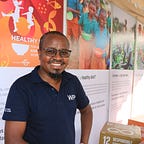Lunch is served
WFP starts school lunches for refugees
“I had black tea and injera for breakfast,” says Halima Mohamed, a 10-year-old grade 5 learner. “Normally, we don’t cook lunch at home. My next meal would have been dinner.”
Halima’s tale is all too familiar in the refugee camps in Dadaab and Kakuma in Kenya. For the 121,000 school children in the camps, the lack of food often means they end up concentrating on their stomachs rather than their books, affecting their ability to reach their full potential.
For Halima and her fellow pupils at Central Primary School in Dadaab, this new school year brought great tidings: the World Food Programme (WFP) started providing school lunches .
Instead of only giving a mid-morning snack, now school children in the 43 primary schools in both Dadaab and Kakuma refugee camps, will also receive a hot lunchtime meal.
WFP decided to introduce this crucial safety net to protect the nutritional status of children whose health and growth is most affected by the lack of sufficient and nutritious foods.
“Over the past five years, we have had to make multiple ration cuts because of funding shortfalls,” says Daniel Dyssel, head of relief and refugees at WFP Kenya. “These lengthy ration cuts affect the nutrition intake of the young children during a key stage in their development — and this affects their future lives as adults.”
One meal a day
Most refugee families say they cannot afford three meals a day and funding constraints mean that WFP is unable to resume and sustain full rations to the refugees. The last time WFP provided a full ration to refugees was between April and August 2018. Prior to that, varying level of cuts have had to be effected in order to avoid a complete halt in food assistance to the refugees. The gap means that families must find alternative ways of coping, for most eating just one meal daily is the only option.
A major reprieve
Hassan Ahmed is a 58–year-old father of 13. He lives in Hagadera working as a casual labourer. Work is hard to come by. Like many other families in Dadaab, Hassan relies solely on WFP’s food rations.
Hassan’s family eats two meals a day in the first weeks of a new month — immediately after the food distributions. Towards the end of each month, they are forced to cut down to one in order to stretch the food stocks to the next monthly food distribution.
“I have four school-going children,” says Hassan. “The children are now getting lunch in school. This is a big relief for me.”
Better access to education
WFP’s school lunch is helping children concentrate on their studies and they can now stay in school for afternoon lessons. Prior to this meal, most of the learners were skipping afternoon classes.
“It is difficult to revise or do homework or concentrate in class when hungry,” says Halima Mohamed. ‘’It especially hard when revising for exams.”
“The school lunch is helping pupils to come to school prepared to learn,” says Ahmed Abdullahi, head teacher at Central Primary School. “We are likely to have fewer absentees. The pupils will attend classes more routinely.”
This term, WFP is providing rice to pupils, courtesy of the Republic of Korea, and pulses cooked in vegetable oil donated by the American people.
The students have more time in class and fewer interruptions in learning over the course of the school year.
“The lunch has created a better learning environment for the students,” says Ahmed. “We expect better performance this term.”
WFP’s food assistance to refugees is generously supported by Canada, EU Humanitarian Aid, Germany, Japan, Poland, Republic of Korea, Russian Federation, Switzerland, United Kingdom and the United States of America.
